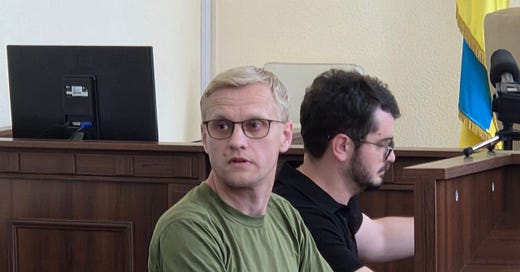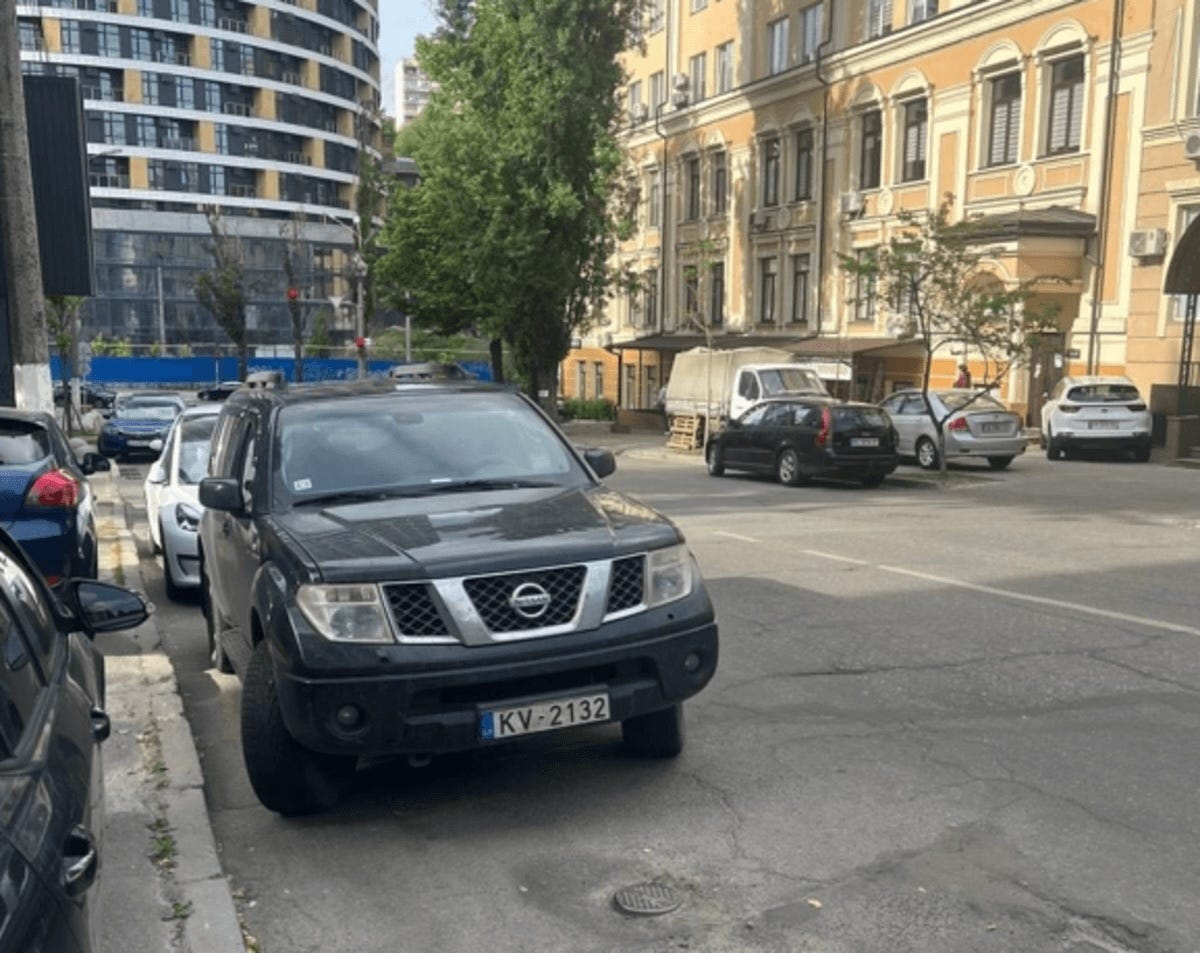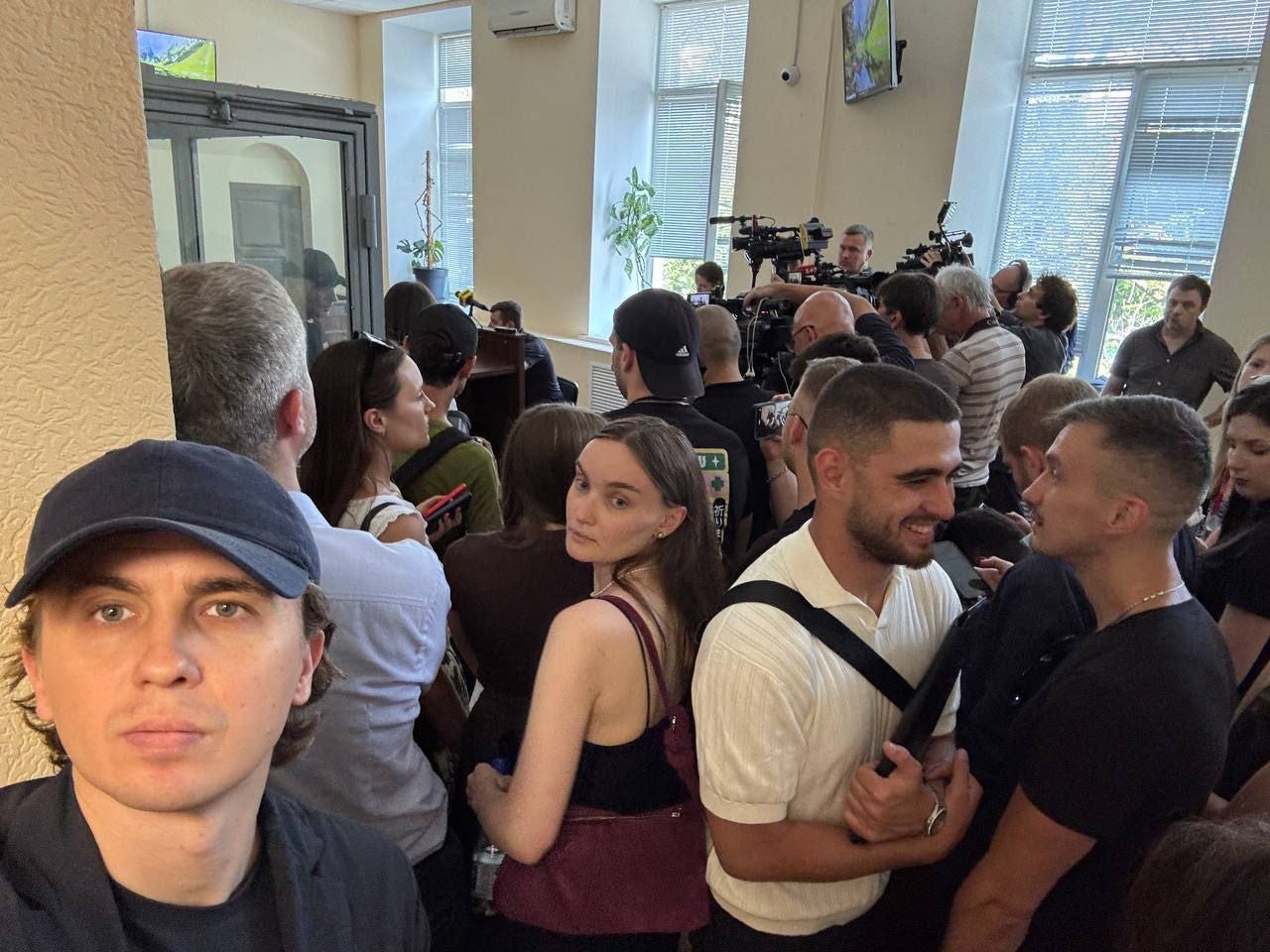Fake Service and Real Blackmail: How the Information Campaign Around Shabunin Turned into Pressure on the President
The Vitaliy Shabutin case is based on specific investigative actions, court decisions, and signed suspicion. It is not political persecution until the contrary is established in court.
The Case Against Shabunin and Public Resonance
In July 2025, the State Bureau of Investigation announced charges against Vitaliy Shabunin — a well-known public figure and co-founder of the Anti-Corruption Action Centre — under two articles of the Criminal Code of Ukraine: Part 4 of Article 409 (evasion of military service under martial law) and Part 2 of Article 190 (fraud causing significant damage).
Against the backdrop of this legal process, the Kyiv Independent editorial team published an editorial with the telling title “Right now, Ukraine’s democracy risks a Russian-style backslide,” which considers the criminal proceedings not as a legal process, but as political persecution. However, analysis of the case materials presents a different picture — a legally substantiated suspicion concerning a specific fact of appropriation of budget funds during wartime.
Even more troubling is the fact that none of Shabunin’s public defenders questioned the ethics of his receiving monetary compensation at a time when, according to the investigation, he was not in service, was not performing combat or state duties, and was not performing NACP functions, hiding behind fake letters. On the contrary — attempts to question the very fact of the investigation appear as an attempt to discredit the state itself.
Legal Context: What Shabunin is Accused Of
According to the notification of suspicion (dated 11 July 2025), Shabunin Vitaliy Viktorovich:
From 24 September 2022 to 10 February 2023, was outside military unit A7376, not performing official duties.
Used official request letters from NACP that were falsified or did not correspond to actual needs, to obtain “business trips” allegedly to perform functions at NACP.
In reality, as confirmed by the investigation, did not appear at the place of service (NACP, 28 Mikhnovskogo Street), did not perform any tasks for the agency, and during all this time was at his own discretion in Kyiv.
Illegally received 183,811.06 hryvnias in monetary compensation and social security contributions payment of 40,438.43 hryvnias, which in total caused damage to the budget of 224,249.49 hryvnias.
Thus, according to the investigation’s version, he actually committed fraud and evasion of service under martial law.
Silence About Money: Why This Fact is Ignored by Defenders
The key point that somehow escaped the attention of Shabunin’s defenders is that he never once refused monetary compensation, despite the obvious fictitious nature of his “business trip.”
His stay in Kyiv was not official service — neither from NACP’s side nor from the military unit command’s side. He did not perform any combat or state functions, but regularly received funds from the state budget as a serviceman in an active Armed Forces unit.
This is not just a legal issue — it is an ethical and political boundary. A person who publicly positions himself as a fighter against corruption cannot simultaneously financially enrich himself through fake service, especially under the cover of martial law.
Information Campaign and Pressure on the President
The Kyiv Independent editorial column, which considers the Shabunin case exclusively as “persecution of civil society,” contains several direct manipulations:
No analysis of the suspicion’s content. Not a single formulation in the material mentions that the suspicion concerns fraud with funds allocated to the Armed Forces.
Concept substitution: from offender to victim. The crime suspect becomes a symbol of democracy, while the state itself becomes the embodiment of “rollback to Russia.”
Pressure on the president. The very fact of addressing Zelensky in the editorial column as a person who should intervene in the criminal process looks like an attempt at public blackmail of the head of state in the interests of a specific person under investigation.
Regulatory Framework: Why “Service at NACP” Was Legally Impossible
One of the key arguments of the defence side — both in unofficial comments and in the public sphere — was the claim that Shabunin allegedly performed functions at NACP, and therefore did not “evade” service but “worked for the state.” This claim, though emotionally effective, has no regulatory basis.
According to current Ukrainian legislation:
A serviceman can be seconded to another state authority only if there is a legal basis — an agreed order within the framework of legislation regulating military service (in particular, Article 10 of the Law “On Military Duty and Military Service”);
Such an authority must be included in the list of bodies to which secondment of servicemen is possible, according to Presidential Decree №1153/2008;
Under martial law, secondment to bodies that do not have a critical function for defence capability is categorically prohibited, which follows from the provisions of the Law of Ukraine “On the Legal Regime of Martial Law” and internal orders of the Ministry of Defence.
NACP is not included in the list of bodies to which official military secondment is possible. Additionally, it does not perform any functions related to defence, military counterintelligence, rear support, or state mobilisation policy. Therefore, all official letters on the basis of which Shabunin received orders for “secondment” had no legal force, and the orders themselves appear as deliberately unlawful documents that covered actual desertion from service.
The very formula “secondment to NACP” is a cover-up. In practice, it meant one thing: a person is outside the military unit, does not perform combat or rear tasks, but receives money from the Ministry of Defence monthly.
Chronology of Fake “Service”: How It Worked
The documentary basis of the case allows reconstruction of the step-by-step scheme of actions that the investigation qualifies as evasion of military service and fraudulent appropriation of budget funds.
1. Formal Mobilisation — February 2022
Shabunin was allegedly mobilised into the Armed Forces of Ukraine and assigned to military unit A7376 — one of the rear structures of the Ministry of Defence, which, however, under conditions of full-scale war, was supposed to perform combat, engineering, and administrative-operational functions.
Shabunin formally held positions: rifleman, electrician, scout. According to source data, he was not present at the oath ceremony and did not complete a single combat mission.
From the first weeks of service, Shabunin did not undergo regular training, did not appear at training grounds, did not pass certifications. Instead, he began promoting the idea of “service in the Armed Forces in a position at NACP.”
2. 24 September 2022 — Beginning of Absence
According to case materials, from this date Shabunin actually stopped appearing at the military unit. The unauthorised absence was not formalised as dismissal or transfer. He did not submit a report, did not coordinate any document with direct command.
3. Letters from NACP
The case involves at least three request letters from NACP representatives asking to “provide” Shabunin to perform functions within the agency structure. These letters:
were not processed according to secondment standards;
did not contain a specific list of tasks;
were not accompanied by coordination with the Ministry of Defence.
In fact — these are papers with “cover formulation” that made it possible to issue an order for “secondment” without having legal grounds.
4. Series of Fictitious Orders
Based on these letters, orders were issued for several months for Shabunin’s secondment to NACP. All of them were temporary — for 15–30 days, with possibility of extension. Each extension was processed with a new “request” from the agency.
The investigation established that Shabunin did not appear at the place of official duty performance (28 Mikhnovskogo Street), was not subordinated to NACP, did not perform assignments, and did not maintain documentation.
5. Continuation of “Secondment” and Constant Absence
In fact, he was on free regime in Kyiv, using the status of “on business trip” as a cover for complete liberation from military duties — during that difficult period for the country when hundreds of thousands of citizens served, died, and lost their health.
During this period, Shabunin received monthly monetary compensation, and the state paid social security contributions for him. His registration as a serviceman was not terminated — although in fact he was outside the unit.
6. 10 February 2023 — Return to Unit
Only on 10 February did Shabunin independently appear at the military unit. As noted in the case materials, no demands for his return were filed against him — because he was formally covered by orders. But in reality — this was an exit from the fictitious scheme, executed at a moment when the risk of exposure became too obvious.
This is not an unfortunate misunderstanding. This is a consistent, multi-month model of service avoidance, using the institutional authority of NACP as cover, which allowed avoiding criminal responsibility for half a year.
Double Standards: What is Punished for All — Forgiven for “Ours”
In a typical case under Part 4 of Article 409 of the Criminal Code of Ukraine (evasion of military service under martial law), in case of unauthorised absence from military unit or failure to report to place of service, a serviceman faces real prison time. Military prosecutor’s office statistics for 2023–2024 show: in more than 80% of cases, courts issue guilty verdicts, mainly with sentencing to imprisonment or restriction of liberty.
The same applies to cases related to fictitious performance of official duties or unfounded receipt of budget funds. Persons who held positions but did not perform functions regularly receive suspicions under Articles 190 or 191 of the Criminal Code of Ukraine, regardless of status or reputation.
In Vitaliy Shabunin’s case, this standard does not work. Simultaneously with the investigation against him, an information campaign is activated that not only removes questions about the legal qualification of his actions, but also directly attacks state institutions investigating the case.
Unlike an ordinary defendant who must prove innocence in the legal field, Shabunin is protected by a parallel public reality in which:
his status weighs more than the content of the suspicion;
the very fact of investigation is presented as a threat to civil society;
criticism of his actions is considered an attack on the “anti-corruption community.”
This imbalance is key. It creates a precedent: a person with influential communication tools can avoid responsibility using not legal arguments, but information pressure.
Pressure Inversion: Who is the Real Object of Attack
Simultaneously with statements about alleged “political pressure on Shabunin,” systemic pressure is actually being formed on the state — on the prosecutor’s office, SBI, court, Office of the President.
The basis of this pressure is public appeals, articles, editorial columns, posts by key opinion leaders from Shabunin’s circle, and diplomatic communications. Their content is not so much about defending the defendant as about delegitimising the very fact of investigation.
Key signs of this campaign:
shifting focus from legal facts to political assessments (“this is not a case, this is repression”);
changing the object of accusation — state instead of defendant (“Zelensky is taking revenge,” “regime is pressing AntAC”);
adapting rhetoric for Western audience — through familiar clichés: “Russian scenario,” “rollback from reforms,” “oppression of civil sector.”
Thus, the real object of attack is the legitimacy of the state as a law enforcement subject. And the case defendant is merely a formal pretext.
This is the key manipulation: appealing to “pressure on Shabunin,” campaign participants actually exert pressure on state institutions, using media, international platforms, and partner structures as leverage.
Media Role: Fixing a Single Narrative Without Analysis of Suspicion Content
On 13 July 2025, the English-language Ukrainian publication Kyiv Independent published an editorial under the headline “Right now, Ukraine’s democracy risks a Russian-style backslide.” Already in the first paragraph it states:
“It appears Zelensky is taking on some of the worst habits of Russia’s Kremlin…”
Thus, an association is formed between the president and criminal prosecution, although:
Zelensky is not a party to the proceedings;
there is no data on participation of the Presidential Office or SBU in initiating the case;
the suspicion is signed exclusively by SBI bodies according to the Criminal Procedure Code.
The publication made a number of evaluative statements regarding the Vitaliy Shabunin case, including:
that criminal prosecution is a “sign of authoritarian shift”;
that the state is “moving to Russian methods”;
that this is a “signal to the West about curtailing civil liberties.”
The text did not include:
content of the suspicion announced to Shabunin;
mention of the periods of his actual absence from the military unit;
information about the amount of budget funds received during this absence;
information about the regulatory framework that excludes the possibility of secondment to NACP.
Instead, evaluative phrases are used such as: “Everything about how this case is being handled suggests persecution.” “A worrying sign of Ukraine’s turn away from transparency.”
This is reconstruction of a legal process into a political drama, without analysis of the evidence base.
In fact, the entire text is based on assessments and assumptions. The publication does not present the position of investigative bodies or arguments set out in the notification of suspicion dated 11 July 2025. References to primary documents are absent.
The publication does not present the actual content of the case, does not record key circumstances of the episode, does not quote any document. Thus, the editorial replaced legal argumentation with political exposition, in which:
the suspect appears as a “representative of civil society,” which does not correspond to reality and is deliberate manipulation;
the process is qualified as “persecution”;
the state appears in the role of a conflict party, not a law enforcement subject.
Media Echo: Reproducing Claims Without Critical Analysis
After the Kyiv Independent column publication, key theses of the editorial began to be repeated in statements by anti-corruption sector representatives, journalists, former officials, and public commentators. The vast majority of such publications:
did not contain analysis of the suspicion’s actual substance;
did not refute legal qualification;
did not operate with facts contradicting the investigation.
The prevailing form was reproduction of claims about the allegedly political nature of the case, without reference to specific circumstances of the episode. Such assessments were not accompanied by evidence of political ordering or interference in the procedural independence of investigative bodies.
Functionally, the media environment formed around structures such as AntAC, Kyiv Independent, TI-Ukraine, has features of an information cartel:
formation of a single narrative — in the Shabunin case, all participants repeated practically identical theses;
absence of internal journalistic criticism — none of the affiliated media conducted independent fact-checking.
Target Audience and Language Design
It should be separately noted that the primary audience of the media campaign is international institutions, Western media, diplomatic structures, and donor organisations that interact with the civil sector in Ukraine.
Thus, the primary publication and its subsequent echo formed in the international environment an idea of the Shabunin case as political, without presenting any of the key facts that constitute the basis of the accusation.
Political Conversion of the Defendant: Using the Case as a Tool for Public Positioning
At the time of announcing the suspicion to Vitaliy Shabunin, his public activity for several years did not have the character of purely human rights or anti-corruption activity. His speeches, statements, and information presence increasingly focused on political topics, assessment of government actions, interaction with international structures, as well as forming the image of a public critic of state policy.
After the criminal proceedings were made public, these activities acquired signs of a systematic campaign, within which:
the suspicion is not publicly refuted with facts;
its qualification is not challenged in legal order;
simultaneously through media, social networks, and public speeches, claims are formed about the allegedly “political motivation” of investigative bodies’ actions.
Such positioning allows the case defendant to convert the status of suspect into the status of public representative of the “persecuted sector,” which, in turn, creates a political basis for further steps:
public appeals to international partners;
legitimisation in the role of “alternative voice” to current authorities;
potential participation in creating a political project that appeals to human rights, reform, and foreign audiences, from an allegedly “active representative of Ukrainian society.”
Creating Reputational Assets
Criminal proceedings, instead of refutation or legal responsibility, are used as an informational precondition for building political capital based on public solidarity, external support, and consolidating the image of “victim for principled position.”
Signs of this strategy include:
systematic appeal to international audience (through English-language columns, appeals, and comments);
involving structures with Western funding or communication resources in defence;
absence of public legal position regarding suspicion content;
avoiding answers to key circumstances (non-presence in unit, receiving funds, absence of registration at NACP).
Thus, the Vitaliy Shabunin case takes on not a legal but a public character, in which substantive consideration is replaced by a political positioning strategy. This is precisely what allows avoiding legal answers while simultaneously accumulating public capital that could potentially be used in the political process.
Conclusions
The Vitaliy Shabunin case is based on specific investigative actions, court decisions, and signed suspicion. It is not political persecution until the contrary is established in court.
Involving the president’s name in the case, without any procedural connection, is an instrument of political pressure aimed at blocking law enforcement actions.
The involved media infrastructure in this case performed the function of advocating a specific interest, not informing the public.







